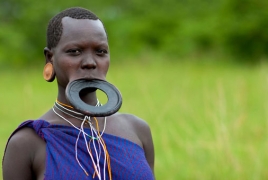 ‘Fashionable and beautiful’ lip platesPainful tradition of Ethiopian tribes The lip plate, also known as a lip plug, or lip disc, is a form of body modification. Increasingly large discs (usually circular) are inserted into a pierced hole in either the upper or lower lip, or both, thereby stretching it. The term labret denotes all kinds of pierced-lip ornaments, including plates and plugs. PanARMENIAN.Net - Although labial plates were also traditionally worn by Suya men of Brazil (most no longer wear plates), Sara women of Chad (ceased wearing plates in the 1920s), the Makonde of Mozambique (ceased wearing plates several decades ago), and the Botocudo of coastal Brazil (in previous centuries, both men and women wore plates), the only tribes that still follow this tradition are the Mursi and Suri tribes of Ethiopia, for whom it is an expression of female maturity and a sign that the woman has reached child-bearing age. It is also a distinguishing trait that ensures she is not mistaken for a member of neighboring rival tribes who either do not pierce their lips (Kwegu tribe) or only wear small plugs inserted into their lower lips (Bodi tribe). Besides, it’s still considered to be fashionable and beautiful. Archaeologists say that labrets have been independently invented no fewer than six times, in Sudan and Ethiopia (8700 BC), Mesoamerica (1500 BC), and Coastal Ecuador (500 BC). It is uncertain how this bizarre custom came into being. According to Medical Bag, one theory is that lip plating originated as a deliberate disfigurement designed to make women and young girls less attractive to slave traders. Some researchers claim that the size of the lip plate (the bigger the better) was a sign of social importance or wealth within the tribe. Another analysis indicated that the bigger the size of the lip plate, the bigger the dowry a bride would receive on her wedding day. For example, the larger the lip plate, the greater number of cows the bride’s father can demand in his daughter’s dowry. But some researchers dispute this theory, arguing that marriage of most tribal girls, as well as the size of their dowries, is prearranged long before their lips are cut. Others suggest that lip plating is simply an ornamentation meant to symbolize a woman’s strength and self-esteem. The practice is also described as being a sign of social maturity and reaching reproductive age, thus indicating a girl’s eligibility to become a wife. The tradition is customarily performed from 6 months to a year before a young girl is to marry, usually around the age of sixteen. During an initiation ritual, a small incision of between 1 and 2 cm in length is made in the lower lip. This ritual is usually performed by their mother or another kinswoman. A wooden peg or ceramic disc is placed in the incision and this remains there for approximately 3 weeks or until the wound has healed. The peg is then replaced with a slightly larger disc, thereby stretching the lip gradually. This stretching process will continue until the lip has an opening of about 4 cm in diameter. At this point, the first clay lip plate will be inserted. To accommodate the lip plate, at least two and sometimes four lower front teeth are extracted. Each woman crafts her own lip plates and decorates them with pride. The stretching process using larger and larger lip plates will continue until a disc of about 10 to 15 cm will fit into the lower lip. There are reports of some women who boast lip plates that are 25 cm in diameter, though this is not the norm. This entire stretching process usually takes several months to complete. Because lip plugs make talking difficult, women only wear theirs in the company of men, but remove them to eat and sleep or when they are only in the company of women or children. While men have their body beautification requirements as well, they are much less taxing. The men usually paint their bodies with a basic paint made from herbs and plants mixed with soil. Their ritual involves the tribesmen covering themselves with it before sculpting it into patterns. It’s rumored that in contemporary culture, Mursi girls 13 to 18 years of age may make their own decision as to whether or not to wear a lip plate. Many young girls have started to choose not to stretch their lips, because the process of removing their lower teeth can be traumatizing, despite being referred to distastefully as ‘Kwegu’ for doing so. Lusine Mkrtumova / PanARMENIAN.Net, Photo: Invision Images How collection of horned creatures turned into museum New York’s first female crime boss World’s largest boneyard An Italian photojournalist’s journey through the pandemic Quarantine in metropoles Town without newborns and dead Nine months in the Pacific |